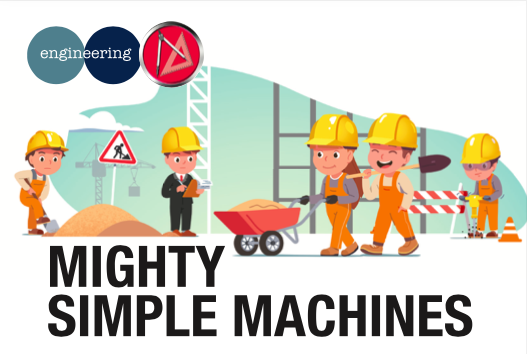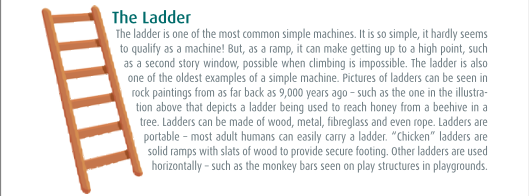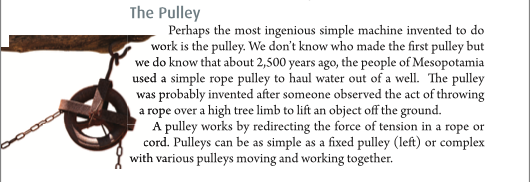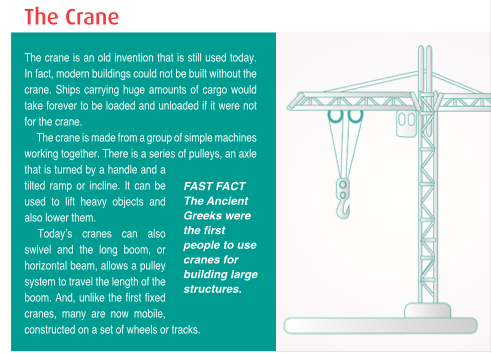
MIGHTY SIMPLE MACHINES
Humans have been learning and inventing since the beginning of time. Our evolving use of tools have allowed us to create useful machines. Simple machines, our earliest inventions, do work with only one or a few moving parts. The greatness of a simple machine is that it changes the direction or magnitude of a force, to make our work easier. Gravity, one of the strongest forces, is defined by the crane, constructed using all six of the simple machines. Your arm does work by lifting, throwing, and rotating. In this way, your arm acts as a simple machine. A wheel does work by moving, or rolling, an object from one place to another. Moving a heavy thing up a hill is facilitated by using a ramp. And hauling a heavy object up off the ground is possible when we use a pulley, an effective part of the crane.
THE LADDER
The ladder is one of the most common simple machines. It is so simple, it hardly seems to qualify as a machine! But, as a ramp, it can make getting up to a high point, such as a second-story window, possible when climbing is impossible. The ladder is also one of the oldest examples of a simple machine. Pictures of ladders can be seen in rock paintings from as far back as 9,000 years ago – such as the one in the illustration below that depicts a ladder being used to reach honey from a beehive in a tree. Ladders can be made of wood, metal, fiberglass, and even rope. Ladders are portable – most adult humans can easily carry a ladder. “Chicken” ladders are solid ramps with slats of wood to provide secure footing. Other ladders are used horizontally – such as the monkey bars seen on play structures in playgrounds.


RUBE GOLDBERG MACHINES
In the 1950s, Rube Goldberg was a cartoonist who started his career as an engineer. He began drawing cartoons of simple machines linked together. But the funny part was that the tasks were very simple compared to the solutions Goldberg designed to complete them. Watch the video below to see how engineers construct an elaborate bell ringer.
https://www.rubegoldberg.org/rube-resources/
If you’re a parent, a teacher, or a student, Rube Goldberg books, projects, and digital games are a great way to engage kids in STEAM and teach Simple Machines.
We recommend Rube Goldberg’s Simple Normal Humdrum School Day which comes with paper projects and lesson plans!
THE PULLEY
Perhaps the most ingenious simple machine invented to do work is the pulley. We don’t know who made the first pulley but we do know that about 2,500 years ago, the people of Mesopotamia used a simple rope pulley to haul water out of a well. The pulley was probably invented after someone observed the act of throwing a rope over a high tree limb to lift an object off the ground. A pulley works by redirecting the force of tension in a rope or cord. Pulleys can be as simple as a fixed pulley or as complex with various pulleys moving and working together.

THE CRANE
The crane is an old invention that is still used today. In fact, modern buildings could not be built without the crane. Ships carrying huge amounts of cargo would take forever to be loaded and unloaded if it were not for the crane. The crane is made from a group of simple machines working together. There is a series of pulleys, an axle that is turned by a handle and a tilted ramp or incline. It can be used to lift heavy objects and also lower them. Today’s cranes can also swivel and the long boom, or horizontal beam, allows a pulley system to travel the lengths of the boom. And, unlike the first fixed cranes, many are now mobile, constructed on a set of wheels or tracks.
FAST FACT
The Ancient Greeks were the first people to use cranes for building large structures.

SUBSCRIBE TODAY! VISIT: www.brainspacemagazine.com
For more engineering fun, check out our friends at The Rube Goldberg Institute for innovation and creativity!

